MARIANI’S
December
21, 2008
NEWSLETTER

"Madonna
and Child" by Raphael
MERRY CHRISTMAS!
~~~~~~~~~~~~~~~~~~~~~~~~~~~~~~~~~~~~~~~~~~~~~~~~~~~~~~~~~~
SUBSCRIBE AND
UN-SUBSCRIBE: You may subscribe anyone you wish
to this newsletter--free of charge--by
clicking here.
TO READ MY COLUMN ON "DINING OUT
IN SANTA FE" in DIVERSION MAGAZINE,
click
here.
In
This Issue
ALONG THE BASQUE COAST By John Mariani
NEW
YORK CORNER: Felice and Salumeria
Rosi
by John Mariani
WINE:
MARCHESI
DI BAROLO CHALLENGES BARBARESCO SNOBS by
John Mariani
QUICK
BYTES
~~~~~~~~~~~~~~~~~~~~~~~~~~~~~~~~~~~~~~~
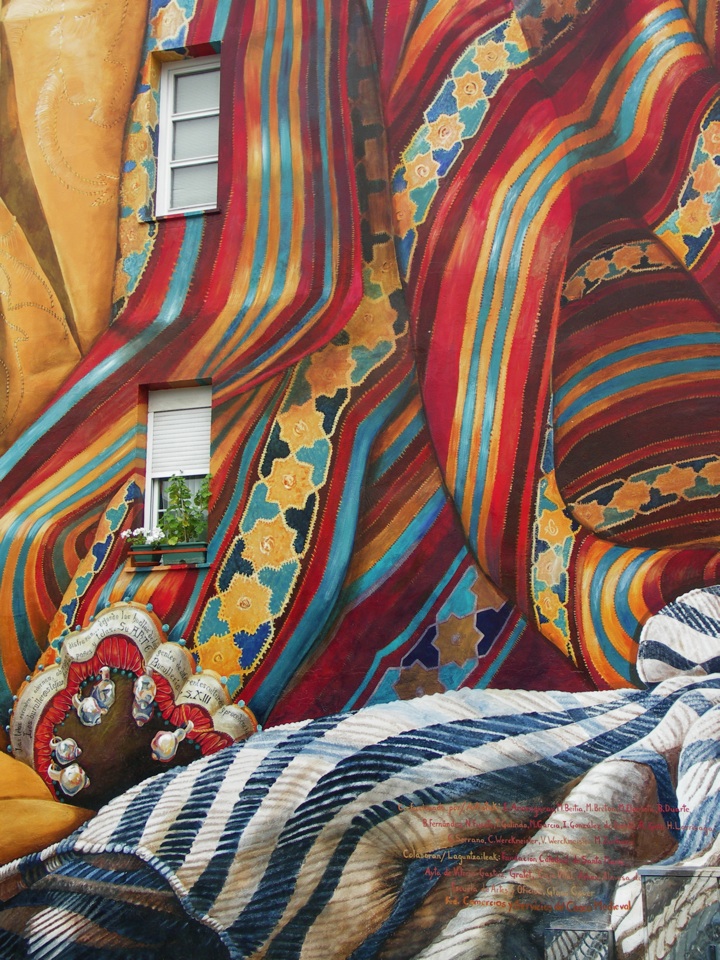 DINING OUT
ALONG THE SPANISH BASQUE COAST
DINING OUT
ALONG THE SPANISH BASQUE COASTPart 2
by
John Mariani
Photos by Galina Stepanoff-Dargery
From San
Sebastián, Spain, you can
drive either East to Biarritz
or, as
my wife and I recently did, west on Route N634 along the rippling
seacoast,
through small cities and tiny towns, many with ancient Basque names
(the Basque name for their region is Euskadi) that contain those
identifying x’s
and z’s within their
spelling. Many are fishing ports--large ones like Algorta, picturesque
small ones like Zumaia, Getaria, and Donostia--and the arrantzaleak (fishermen) pray
to their local saints to provide the best seafood in season, from sea
bream to hake, from cod to mullet.
Basque cuisine is rich in the local
provender of mushrooms, which are eaten on certain feast days, apples,
often made into cider enjoyed at tapas eateries, bean, and the rich
bounty of the sea. The region
even has museums of gastronomy, including one, in Tolosa,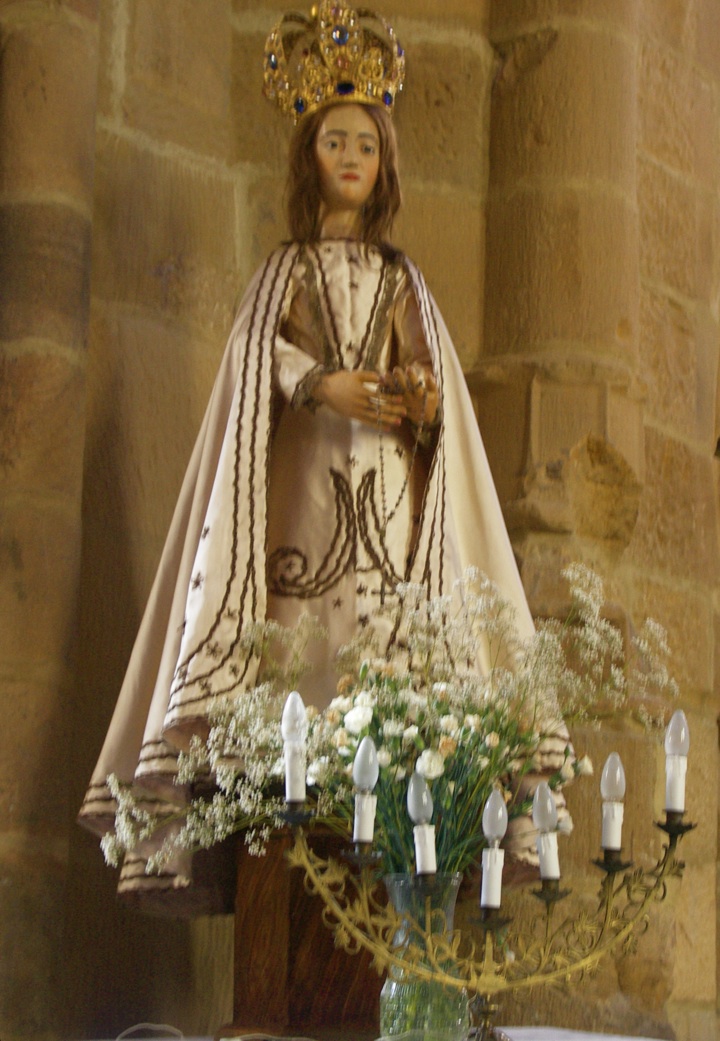 devoted solely to the history of pastry.
devoted solely to the history of pastry.
Less
than an hour from San Sebastián is the wonderful old,
cobblestoned
fishing town of Getaria, cuddled
around a snug harbor, with the ancient Gothic church named San
Salvador, whose floors are slanted upwards towards the sweetly
configured Virgin Mary statue (right),
a place of devotion by Basque fishermen.
The harbor is dotted
with
seafood restaurants, where what you will eat is what just came up from
the docks that morning. The prettiest perch is at Kaia (General Arnao 4; 94-314-0500),
a restaurant
above the harbor,
with an extensive menu that includes the velvety bacalao dish called pil-pil, made by
whipping olive oil and garlic until it becomes thick as mayonnaise.
Downstairs, the more casual Kai Pe specializes
in grilled
seafood. But my favorite place is Iri-Bar (Kale Nagusia; 94-314-0406) cattycorner to
San Salvador Church. 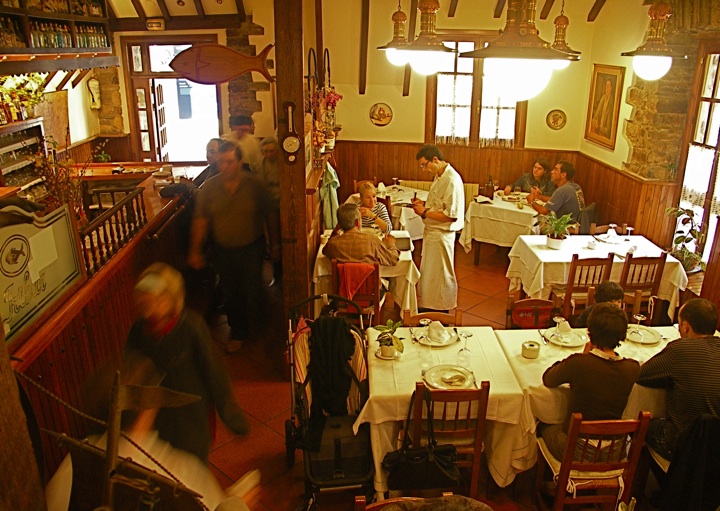 Decked
out with fishnets, ship's steering wheel, and old stonework (left), it
has a coziness and the feel of a place that long ago perfected
its cuisine.
Decked
out with fishnets, ship's steering wheel, and old stonework (left), it
has a coziness and the feel of a place that long ago perfected
its cuisine.
The chef-owner is a young, genial woman named Pili
Manterola, the grand-daughter of Iri-Bar's founder. She keeps pretty
much
to the kitchen or outside where they have a charcoal grill. Inside the
waitstaff puts on a fairly somber face and they could be more attentive
to
guests. This is a very popular place, especially on weekends when
families pile in, so if you don't make a reservation you will sit on
the mezzanine, which is
actually a wonderful spot from which to watch the Spaniards file in,
sit down, eat and drink.
The large menu is built around the day’s fish,
so
we ordered a lustrous and tender octopus salad, quickly grilled prawns
glossy with olive oil, and rodaballo
(turbot),
which, like all the fish here, is
grilled over an outdoor charcoal grill, the flesh moistened with
frequent sprinklings of olive oil, white wine, and garlic. The
best
seafood is no longer cheap in Spain, but with a bottle of good house
wine—a white verdejo (about
6 euros)—at Iri-Bar, we were happy to
have had such a delicious and very lavish meal for under $90, which
included a lovely light,
warm cheesecake and
creamy rice pudding to finish. As everywhere in Spain, tax and
service are included, so tipping is not necessary.
Farther west, we found Eneperi
Jatetxea
(right) off a hairpin turn
along
the swerving coast road between Bakio and Bermeo. Timbered
throughout
with a barn-like roof, plenty of sailor memorabilia—even a small
museum of marine artifacts--and waitresses in traditional blouses and
long skirts, this is a rustic and beautiful restaurant, albeit with a
somewhat
lax, even obtuse service staff, that draws men (predominantly) for a
business lunch or couples for a serious night out. Here the menu still
holds to regional cookery
but
with considerable flair in dishes like green Basque peppers stuffed
with onion and pork (16.50€), the moist tail of hake (19€) in a red
pepper sauce, and
an ice cream made from fresh cheese and walnuts with Chinese
gooseberries (6.50€). It is a bit more expensive than some other
restaurants in the region, but you are getting atmosphere galore,
including a gorgeous panorama on the sea. The winelist is very good,
the glassware thin, the tablecloths starched.
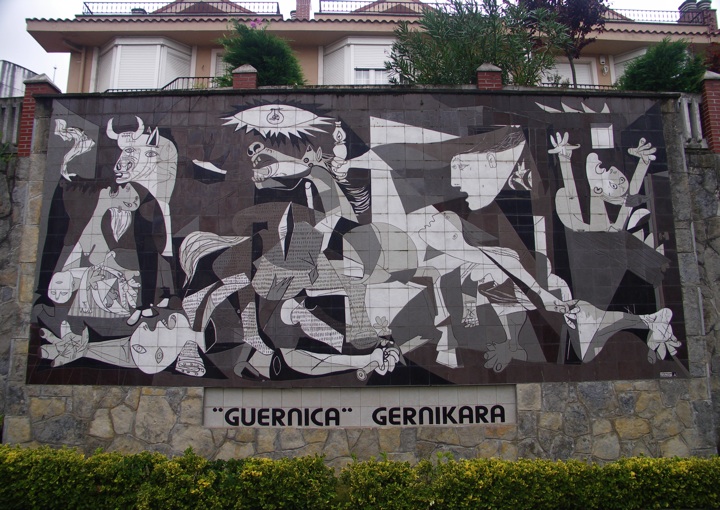 The city
of Gernika-Lumo
is a requisite stop on the Basque tour, not because it is particularly
beautiful but because of its significance as a town
deliberately used by Franco and
his conspiring friend Adolph Hitler in 1937 as a bombing run for what
was to
be called the blitzkrieg of Poland two years later.
The event was abstracted by Picasso into one of his finest paintings,
now in Madrid's National Museum of Art (the one to the
left is an outdoor copy in Gernika), The
air raid devastated the town, and so Gernika has become a symbol of
both world peace and a reminder of the horrors of war. Three
trees
at the Casa de Las Juntas now commemorate the event, and the local
museum displays the agonies of what occurred.
The city
of Gernika-Lumo
is a requisite stop on the Basque tour, not because it is particularly
beautiful but because of its significance as a town
deliberately used by Franco and
his conspiring friend Adolph Hitler in 1937 as a bombing run for what
was to
be called the blitzkrieg of Poland two years later.
The event was abstracted by Picasso into one of his finest paintings,
now in Madrid's National Museum of Art (the one to the
left is an outdoor copy in Gernika), The
air raid devastated the town, and so Gernika has become a symbol of
both world peace and a reminder of the horrors of war. Three
trees
at the Casa de Las Juntas now commemorate the event, and the local
museum displays the agonies of what occurred.
There aren't really a lot of places
to eat
in Gernika (one of the better known, Zallo Barri, was closed when we
visited), but the quite modern and charming Zimela (below; Carlos Gangoiti, 57; 946 251 012)
is bright and colorful, with a wall of windows and big,
generously spaced, well-set tables. But, again, the staff that
seemed nowhere to be found after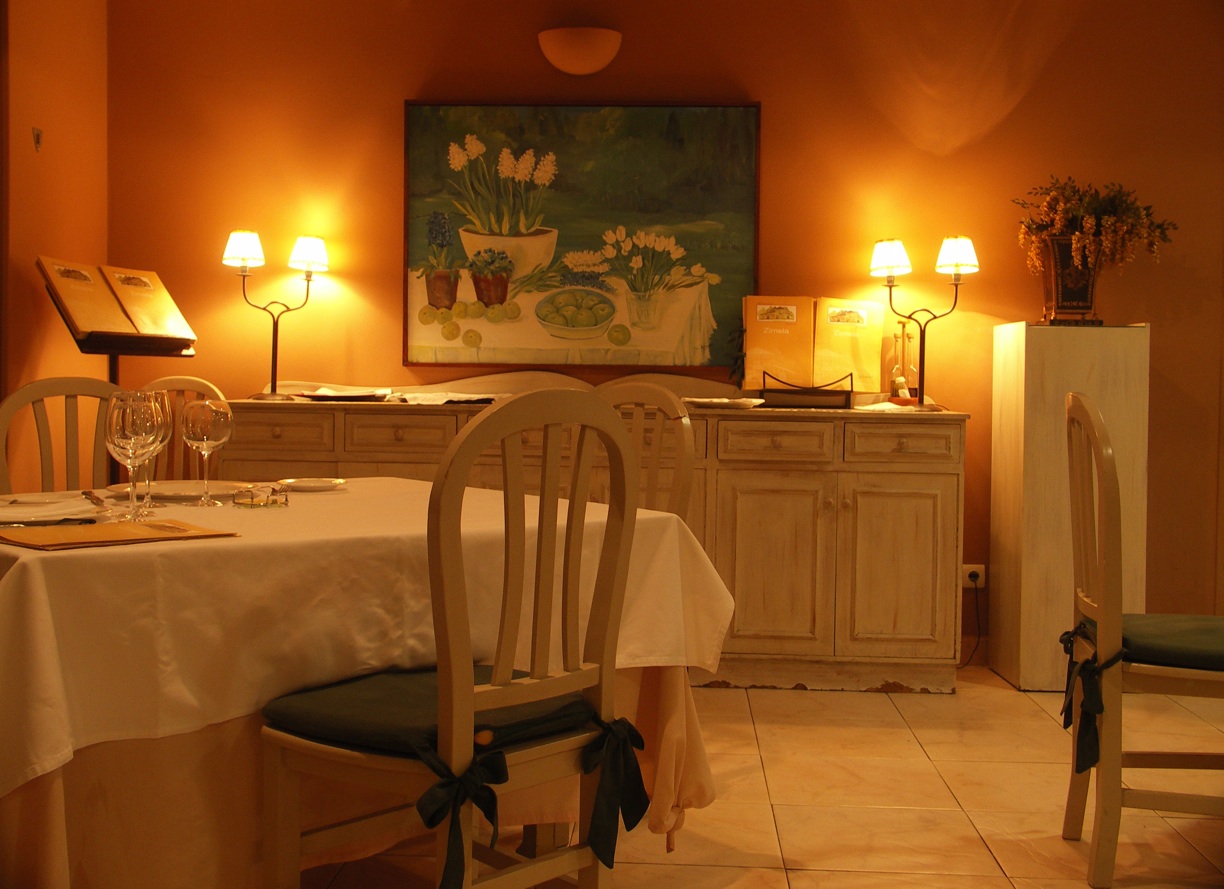 food was served. We did enjoy sweet white asparagus (12€)
stuffed
with vegetables and topped with a thin slice of salmon; very good
scrambled eggs with local mushrooms (14€); finely grained beef sauced
with a local cheese, and a puree of potatoes and green peppers
(17€). But
fried
hake with green peppers (15€) was bland in every way. There was only
one other table occupied that evening, and the guests were feasting
on what
we probably should have ordered--a thick steak, cut, as in Florence,
into slabs and seared a la
plancha tableside. The aromas alone
were inebriating.
food was served. We did enjoy sweet white asparagus (12€)
stuffed
with vegetables and topped with a thin slice of salmon; very good
scrambled eggs with local mushrooms (14€); finely grained beef sauced
with a local cheese, and a puree of potatoes and green peppers
(17€). But
fried
hake with green peppers (15€) was bland in every way. There was only
one other table occupied that evening, and the guests were feasting
on what
we probably should have ordered--a thick steak, cut, as in Florence,
into slabs and seared a la
plancha tableside. The aromas alone
were inebriating.
We
also had dinner in Gernika at one of the most modest restaurants I've
ever been
to, and, to paraphrase Winston Churchill, it had a lot to be modest
about: Restaurante Viejo-Rudolfo,
in the center of town, is little more than a large room grimly lighted
by fluorescent bulbs, with paper tablecloths, and a yellowed copy of
Picasso's
"Guernica" on one wall. The food was negligible--fried vegetables
to pick at, very small veal chops that were overcooked and set on top
of oily fried potatoes, and whatever else the sweet old lady proprietor
recommended
from a menu with x-ed out
items not available that night; there were a lot of x's. The word "honest food" comes
to mind, but if honesty isn't worth a euro, why bother?
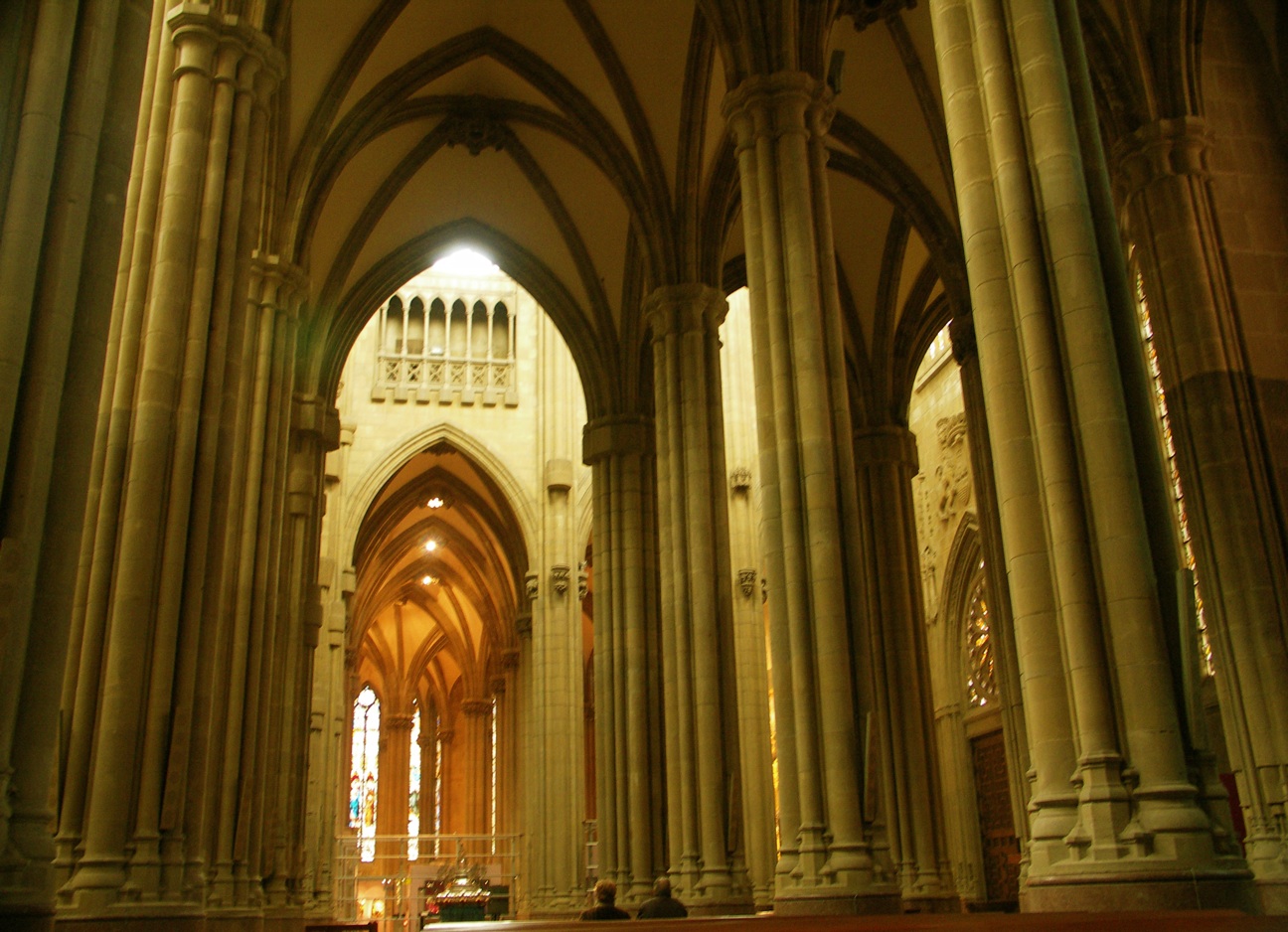 Eventually
we wound our way
south through pine
forests and tiny
towns like Eibar, Urkiola, and Durango, to the beautiful, broad
city of Vitoria, called
Gasteiz in the Basque language. Bustling
and
modern, Vitoria has been very careful to restore and maintain its
historic buildings, fine churches, painted façades (like the one
at the top of this article), and green
parks. It is a youthful city and a walking city, with many streets
closed to motor traffic, including the wonderful main plaza. The New
Cathedral of Maria Immaculada (left)
is so called because it was only inaugurated in 1969. Done in a
neo-Gothic style, it has a magnificence lightened by its height and
elegantly slender columns, wonderful stained glass, and enchanting
expanses of
golden light.
Eventually
we wound our way
south through pine
forests and tiny
towns like Eibar, Urkiola, and Durango, to the beautiful, broad
city of Vitoria, called
Gasteiz in the Basque language. Bustling
and
modern, Vitoria has been very careful to restore and maintain its
historic buildings, fine churches, painted façades (like the one
at the top of this article), and green
parks. It is a youthful city and a walking city, with many streets
closed to motor traffic, including the wonderful main plaza. The New
Cathedral of Maria Immaculada (left)
is so called because it was only inaugurated in 1969. Done in a
neo-Gothic style, it has a magnificence lightened by its height and
elegantly slender columns, wonderful stained glass, and enchanting
expanses of
golden light.
In Vitoria we dined at one
of
the oldest restaurants in northern Spain, El Portalón, (below)
hidden
behind a
nondescript oak door--you'd easily pass it without knowing it's a
restaurant--on a three-story building dating to the 15th
century,
inside a warren of varnished staircases, rough wooden beams, tiled
floors, and antique artwork. There was a 23€ lunch, wine
included, that we took good advantage of, enjoying the hearty,
generous food, from from
a thick, red bean soup riddled with cabbage and slices of blood
sausage, to squid cooked in its own ink with rice, and a platter  of
flavorful, fatty morsels of oxtail with sliced fried potatoes. Puff
pastry with vanilla cream and chocolate sauce and a cheese tart
with chocolate bits and raspberry sauce were lovely endings to the
meal. Service, yet again (sigh), was perfunctory at best.
of
flavorful, fatty morsels of oxtail with sliced fried potatoes. Puff
pastry with vanilla cream and chocolate sauce and a cheese tart
with chocolate bits and raspberry sauce were lovely endings to the
meal. Service, yet again (sigh), was perfunctory at best.
Lekeitio
is a pleasant seaside
town worth a walk of an hour or two. The most recommended
restaurant is Egaña (Antiguako Ama, 2; 94 684 01 03), a
good, solid place for typical food at a very fair price. It is a big,
bright room (below) with brown
and white marble tiles, polished wooden chairs, and mirrored walls set
with
orange sconces. Here the service couldn't have been nicer. Go for
the seafood here--grilled crayfish done to a turn (to wash your fingers
they afterwards provide you with a lemon and a dish that looks filled
with mouthwash), a large portion of turbot a la plancha, and
golden fried mullet--with both the fish dishes 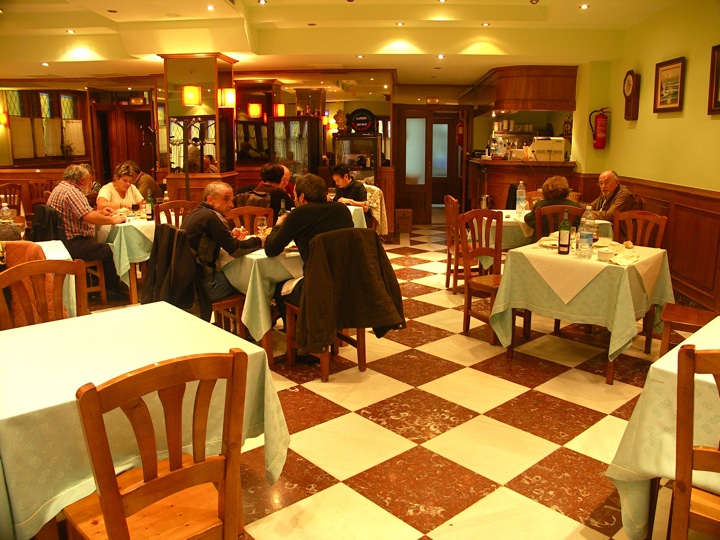 costing
16.50€ each.
costing
16.50€ each.
So
much
has been written about Bilbao
because of
its acquiring the Frank Gehry-designed Guggenheim Museum ten years ago
that
the
city’s Basque character has been somewhat displaced, an evolution that
has been much commented on by the residents of this once industrial
city. The city fathers were, however, prescient in
realizing that in the post-industrial era of the city's history that
the only thing that could draw people to it were the arts, beginning
with the coup of acquiring the Guggenheim, whose armor-like profile,
right next
to a beautiful modern suspension bridge, is now only part of the
extensive series of museums and outdoor esthetics of this very vibrant
competitor to Barcelona and Madrid.
The very best hotel in town
is the
classic Carlton
overlooking the Plaza Federcio Moyua, from which spokes of broad
avenues
lead you to the finest shopping, the many museums, and across the
Bilbao
River to the old town where you still find much of the city's historic
character, especially around the Cathedral of
Santiago, a neighborhood now teeming with new tascas and
cafés that express both the old spirit and the
youthful vitality of this very fashionable city. One of the best new
tapas bars in the quarter is Berton (Calle Jardines 11;
944-167-035), which is
especially known for the quality of its Iberico ham, which hangs by the
score from the ceiling.
On
the other side of the
river, where all the new
cultural facilities are built, two quite modern restaurants exemplify
the city’s culinary creativity right now: Restaurante
Etxanobe (below)
is
located on the third floor of the striking Palaçio de Congresos
y de la
Musica, looking out over the city from glass walls. Well-spaced
tables
and impeccable service lend a sophisticated ambiance to the evening,
which begins with excellent breads and six different olive oils. A
shooter of vegetables and melon was presented along with silver spoons
of a single anchovy with peppers and olive oil. Here grilled
langoustines are scented with vanilla (25€), and a red rockfish with
orange—inventive but not molecular, simple cooking with real
flair. The Ménu Degustación is
57€, with a Ménu Gastronómico at 69€. The winelist here
is one of the most outstanding I've found in the Basque country.
Photo courtesy of
Restaurante Etxanobe
We found a similar streak in the
cooking at Arbola-gaña (Plaza del Museo; 944-42 4657),
overlooking the garden from the top of the superb Museum
of Fine
Arts.
Minimalist in décor and wrapped entirely in glass, with brown
leather
chairs and track lighting and tables set with little bonsai trees,
Arbolaga-gaña
presents its
cuisine artfully: a creamy cheese soup was well spiced and buoyed with
wild mushrooms (13€); garlic-soaked squab (19€) was roasted pink and
sauced with
its own pan juices; and dessert was a tour de force of nine fragile
layers of pastry, sweet cheese and white chocolate
(5.50€).
During our trip we did not find much in
the way of
so-called "molecular cuisine" of the kind pioneered by Spanish chef
Ferran Adria, but one new place did stand out as worth keeping an eye
on
for this kind of daring--Eneko Atxa Azurmendi,
about 15 minutes' drive from Bilbao in Larrabetzu. Here, within
an
ultramodern corporate meeting complex and txakoli winery, young,
handsome Chef Azurmendi (below)
works within a kitchen that reminds you as much of a hospital lab as a
cooking spot, and in fact, he showed us how he uses a centrifuge to
concentrate his sauces.
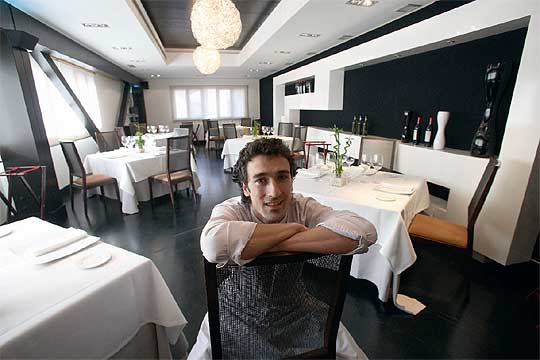 My
wife and I dined, at a good pace, on nine of his dishes, fusionary, but
none as contrived as some of the extravagant molecular cuisine in
Spain
is, but more a canny balance of traditions and modernism,
evident in dishes like Azumendi's "ecological" egg injected with a hot
infusion of baby squid; lobster with aromatic herbs and smoked tea;
pink pigeon cooked over cherrywood; and dazzling chocolate desserts.
My
wife and I dined, at a good pace, on nine of his dishes, fusionary, but
none as contrived as some of the extravagant molecular cuisine in
Spain
is, but more a canny balance of traditions and modernism,
evident in dishes like Azumendi's "ecological" egg injected with a hot
infusion of baby squid; lobster with aromatic herbs and smoked tea;
pink pigeon cooked over cherrywood; and dazzling chocolate desserts.
These are the kind of contrasts of the
very old
and the very new, the very
basic and the very refined, are found throughout Basque gastronomy
right now, and while in the vanguard of modern Spanish cuisine, it is
securely anchored as it always has been to the sea and the land to
which it owes everything.
To read Part One of this
article
click here.
Photo courtesy of Eneko Atxa Azurmendi
~~~~~~~~~~~~~~~~~~~~~~~~~
NEW
YORK CORNER
by John Mariani
Two
wonderful little Italian eateries have opened in Manhattan--one on the
upper East Side, one on the West-- that seem to show the direction we
will all want to go for good food and good
prices this year.
FELICE
Wine
Bar 
1166
First Avenue (at 64th Street)
212-593-2223
www.felicewinebar.com
Charcuterie and small
plates have become quite the gastro-trend of 2008, and I expect it to
carry into 2009 with even more verve. A good template for others
to check out would be the year-old Felice
Wine Bar, whose stress on
wine in no way dilutes the diminishes the options for salumi,
pastas, and main courses at this
charming East Side trattoria.
Rustic, with bare floors and bare wooden
tables, brick walls, a sleek bar backed with wine bottles, Felice's
sweet ambiance is curdled only by the ridiculously loud music they
pipe in for unimaginable reasons. There is also a
46-seat wine bar and a 9-foot
communal table that helps the conviviality even more.
Owner Jacopo Giuustiniani, who comes
from an Italian wine family, and chef Chef Simone Parisotto, more or
less focus on Tuscan fare, while the more catholic winelist has more
than 100 Italian labels at very reasonable prices. Eighteen wines are
offered
by the glass. The prices for the food are also right, for you could
just load up on antipasti, salumi,
and a plate of pasta and be very
happy for under $35 plus a glass or two of wine.
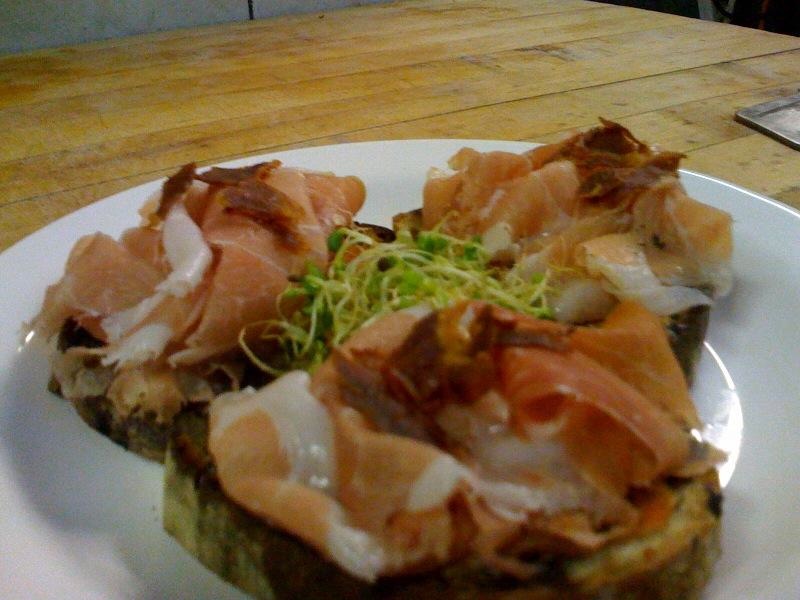 Just plunge right in anywhere--a
platter of crostone (toast)
with a fresh tomato puree and julienne of vegetables, or with artichoke
cream and Speck bacon (left), or with wonderful sweet
eggplant and soft-centered burrata.
Of course you'll want to try the
various cheeses of the day and the salumi
toscani, to be savored with a nice light red or a white Tocai
Friulano.
Just plunge right in anywhere--a
platter of crostone (toast)
with a fresh tomato puree and julienne of vegetables, or with artichoke
cream and Speck bacon (left), or with wonderful sweet
eggplant and soft-centered burrata.
Of course you'll want to try the
various cheeses of the day and the salumi
toscani, to be savored with a nice light red or a white Tocai
Friulano.
Pastas are simple in the true trattoria style, from
linguine with olive oil and garlic flecked with red pepper flakes; the
ricotta-spinach ravioli in a butter sage sauce; or perhaps a
risotto with frutti di mare
lavishly incorporated.
If you're still not done, consider the branzino quickly pan-seared and
then glossed with a salmoriglio,
a dressing of olive oil, lemon,
garlic, parsley, and oregano. Sirloin is cut into slices and
topped with arugula and shavings of Parmigiano.
Felice is not a novel idea but it
is one increasingly popular for reasons that have as much to do with
good taste as easy-on-the-budget pricing.
Felice Wine Bar is open
for lunch Mon.-Fri, for brunch Sat. & Sun., and for dinner nightly.
Antipasti $9-$16, pastas $10-$18, entrees $18-$28.
Salumeria
Rosi Parmacotto
283 Amsterdam Avenue (near 73rd Street)
212-877-4800
www.salumeriarosi.com
"Generally speaking, Italian salumi can be divided into two
broad categories: whole cuts, which include prosciutto, coppa pancetta and insaccati, or ground meat stuffed
in a casing, which include all types of cured and cooked sausages, like
cotechino and mortadella."
So says the website of Salumeria Rosi Parmacotto, which is
similar in style and focus to Felice Wine Bar above but more intensely
devoted to those cured meats just described. The meats themselves come
from a collaboration of Italy's renowned salumi makers, the Rosi
family, and the ebullient Tuscan chef Cesare Casella (below), formerly of Beppe and
Maremma restaurants in Manhattan, and also Dean of the Italian
Culinary Academy at the International Culinary Center in SoHo.
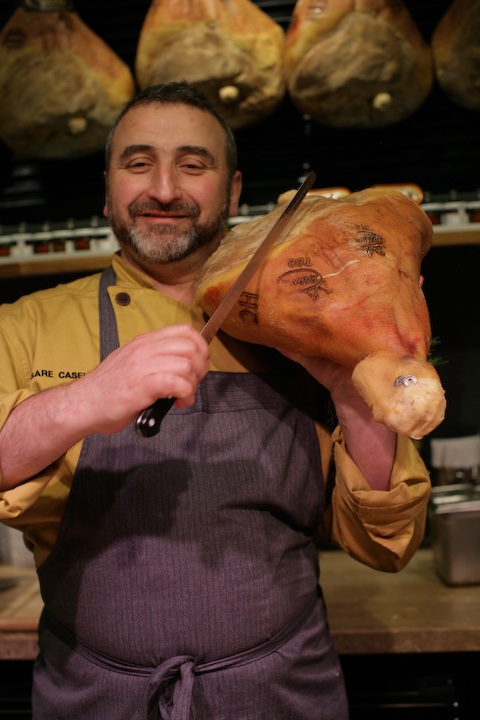 Clearly everything those two masters know has gone into
the superb salumi served in
this tiny, 25-seat eatery (with a mere four seats at the bar, above) on the upper West Side. The
winelist here is not as extensive as that at Felice, and because of the
room constraints for storage, the red wines may come out a little
warmer than ideal.
Clearly everything those two masters know has gone into
the superb salumi served in
this tiny, 25-seat eatery (with a mere four seats at the bar, above) on the upper West Side. The
winelist here is not as extensive as that at Felice, and because of the
room constraints for storage, the red wines may come out a little
warmer than ideal.
There's good bread here--requisite to
accompany the marvelous meats like San Gimignano Prosciutto rubbed with
rosemary, black pepper, and garlic, then grilled; dry-cured
and smoked Speck from
Alto-Adige, quite a bit like German and Austrian bündnerfleisch
hams; the cured pork jowl called guanciale;
the signature cooked
prosciutto; the well-fatted mortadella of Bologna; and the slowly
roasted seasoned loin of pork sliced thin, perfect on a plate or
in
a panino. 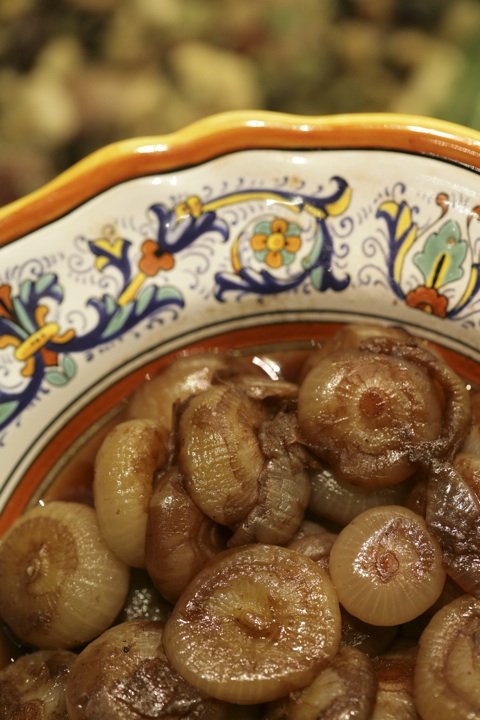 A selection of meats runs $10-$28 per pound.
A selection of meats runs $10-$28 per pound.
These meats might satisfy anyone for a
light repast, but an Italian restaurant must serve pasta, so "SRP"
dishes out one or two per night--although they ran out of the lasagna
our table craved. Instead, we were consoled with malloreddus, a Sardinia pasta shape
in a Roman style, all'amatriciana,
with a good dose of cured pork, red
onions, and tomatoes. There's a plate of sweetly caramelized cipollini onions (right), then
there was slowly-cooked tripe, so tender, so perfumed with tomato and
spiced with Parmigiano; spicy Tuscan spareribs with tomatoes, garlic,
and rosemary reminded me of how much I miss Casella's restaurant
Maremma, and I was happy to see stracotto
(hearty beef brisket stew) with polenta--wonderful for a
cold winter's night, all prepared by chef de cuisine Alexis Pisciotta,
a nice Bronx girl who's worked at Lupa in Greenwich Village and
at London's acclaimed River Café.
Yet another amiable things about SRP is
that it opens at eleven in the morning and stays that way for the next
twelve hours, so if you skipped breakfast or get the munchies after
theater, Lincoln Center, or the movies, you can nosh your way through
as much or as little of this wonderful salumi, cheese, and bread as you
wish, with a good glass of wine to get you to sleep like una bambina.
Antipasti plates run
$4-$9, meats $10-$28.
~~~~~~~~~~~~~~~~~~~~~~~~~~~~~~~~~~~~~~~
NOTES
FROM THE WINE CELLAR
The Marchesi di Barolo Wants to Win Over the Barbaresco Snobs
by John
Mariani
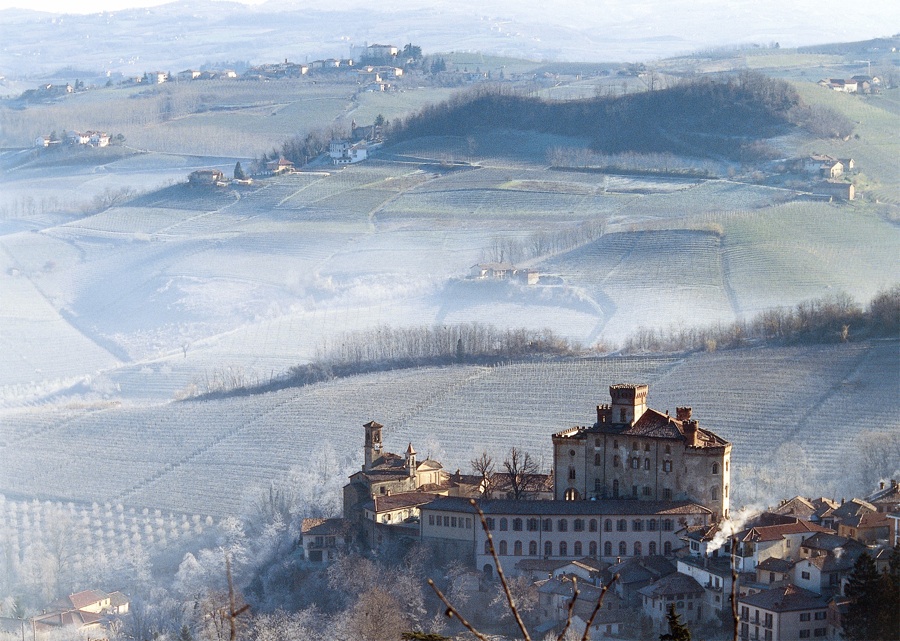 Whenever
a wine snob voices
the cliché that in Piedmont, Italy, Barolo is the masculine
“king” of wines and Barbaresco the feminine “queen,” Anna Abbona,
smiles and shakes her head. “Perhaps it is only that women prefer
Barbaresco because it sounds lighter,” says the owner, with her husband
Ernesto, of the historic Marchesi di Barolo estate (left), which makes both
kinds of wines.
Whenever
a wine snob voices
the cliché that in Piedmont, Italy, Barolo is the masculine
“king” of wines and Barbaresco the feminine “queen,” Anna Abbona,
smiles and shakes her head. “Perhaps it is only that women prefer
Barbaresco because it sounds lighter,” says the owner, with her husband
Ernesto, of the historic Marchesi di Barolo estate (left), which makes both
kinds of wines.
In fact, both wines are made from the same
grape, nebbiolo, which has never produced a wine of distinction outside
of Piedmont, where the chalky soil and humidity (nebbia means “fog”)
are ideal and the location of the vineyards give Barolo and Barbaresco
their different styles. Both wines are known for being aromatic and
silky, often with high alcohol levels, but never jammy. Barolo is
aged longer than Barbaresco (three years, two in barrel vs one to
three, with one in barrel), with riservas spending four or five years
aging. If, then, Barbarescos seem somewhat lighter in body and looser
tannins, they have their own complexity of terroir.
Still, Barbaresco has
achieved a higher
status, largely owing to the fame of Angelo Gaja’s versions, which
often sell for $120 and more. Barolo, kingly or not, has become the
stepbrother—-to Barbaresco.
The Abbonas are trying to balance
the perceptions about the two nebbiolo wines, not least because they
are owners of an estate that dates to the 12th century through the
aristocratic Falletti family that claimed to have given Barolo wine its
name. The Abbonas acquired Marchesi di Barolo in 1929; Anna, 50, (right) married
into the family and has become known for her tireless efforts not just
to restore the estate but to head the Wine Tourist Movement in Italy to
promote winery estates as travel destinations.
“We are not just a company,” she
insisted over lunch with me at Angelina's, an Italian
restaurant in
Tuckahoe,
NY. “We are a family
winery, and we know what we have to do with our wines by controlling
every aspect from the vine to the bottle. We are not just looking
to get rich. In Italy big wineries are buying small ones and changing
their wines for a global taste. In the last 15 years people just want
to be impressed by simply tasting a wine. You have to drink a wine, not
just taste it, and we make our wines with elegance so they can give
pleasure throughout a meal.”
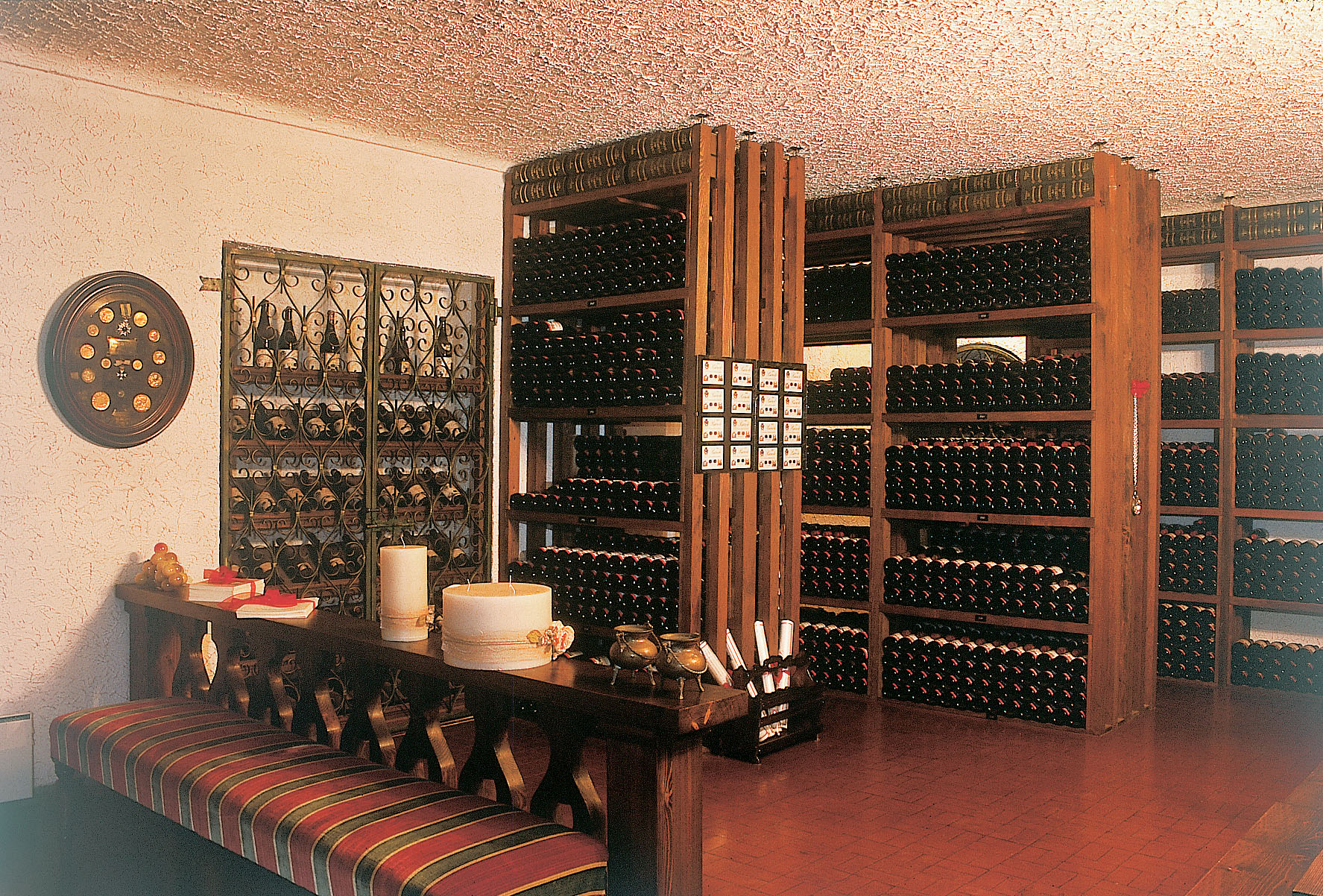 To this end Marchesi di Barolo, while
invested with the most modern vinicultural technology, makes its wines
in the reserved, highly refined style they have for decades. They
still use some of the big oak barrels that date back 200 years, this at
a time when many Piedmont wineries extensively use smaller barriques
made from new wood.
To this end Marchesi di Barolo, while
invested with the most modern vinicultural technology, makes its wines
in the reserved, highly refined style they have for decades. They
still use some of the big oak barrels that date back 200 years, this at
a time when many Piedmont wineries extensively use smaller barriques
made from new wood.
The estate is also famous for its
library (left) of 35,000
wines, with vintages dating back to 1859 and
still offering limited quantities to American clients of vintages from
1938, 1947, 1948,1961,  and 1964 (the U.S. is the estate’s most
important market, exporting 20 percent of its production here), which
allows a winelover truly to assess both the consistency and the changes
in Piedmontese winemaking over the last eight decades.
and 1964 (the U.S. is the estate’s most
important market, exporting 20 percent of its production here), which
allows a winelover truly to assess both the consistency and the changes
in Piedmontese winemaking over the last eight decades.
With
Anna, who speaks English as fast as
she does Italian, I tasted several of her wines. The 2004 ($55),
aged for one year in bottle, had a wonderful warmth on the palate,
tight in the nose, as expected from a young vintage, with a charming
rose-like bouquet. An older vintage, 1999 ($90), had achieved marvelous
maturity, very elegant, full bodied, and expressive of nebbiolo’s
underlying spiciness. Not surprisingly, a 1990 ($125) showed off a
classic, older style of brawniness, but it was a highly satisfying wine
with plenty of vitality left.
The winery’s Estate Vineyard series comes from
their finest vineyards, like Cannubi, Coste di Rose, and Sarmassa, and
spends 1-2 years in bottle; the 2003 vintage ($63) was still dark,
intense, with a truffle-like nose and a developing balance of elements
still coming into complex focus.
We then tasted a wine that came from
grapes grown entirely in the prestigious Cannubi vineyard, considered
the finest in the region, which faces east and absorbs the blessed
benediction of the sun. The Abbonas own about two-thirds of the
vineyard, and their Cannubi label represents one of the highest
achievements of Piedmontese winemaking today.
Grapes are all hand-picked, fermented in
stainless steel, then part of the wine is aged in oak for two years,
with another portion in moderately toasted French oak for one year;
after blending they spend a year in bottle. I tasted the 2004 ($100),
which has a high 14.5 percent alcohol level, yet the wine did not blast
my palate with either heat or overripe fruit flavors. It was
certainly full bodied, and the oak is still present, so I’ll look
forward to a rematch in about five years.
Till then, I’ll content myself
with the idea of getting hold of one of those library wines to give me
an idea how the Marchesi di Barolo wines of this century will develop
in the decades to come.
John
Mariani's weekly wine column appears in Bloomberg Muse News,
from which this story was adapted. Bloomberg News covers Culture from
art, books, and theater to wine, travel, and food on a daily basis, and
some of its articles play on the Saturday Bloomberg Radio and TV.
~~~~~~~~~~~~~~~~~~~~~~~~~~~~~~~~~
THE ACLU IS ALREADY CHARGING THE COPS
WITH COERCION
Prosecutors in Multnomah
County, Oregon, obtained a confession from 275-pound murder suspect
Tremayne Durham after promising him a buffet of all his fast food
favorites, including a bucket of KFC, a bucket of Popeye’s fried
chicken,
carrot cake, pizza, two calzones, lasagna, and ice cream in change for
his confession, costing the town $41.70 instead of a trial that would
have cost $4,000. Durham got a life sentence.
SO, WHICH WOULD YOU RATHER WATCH?
“It seems half our [food] TV programmes consist of
loud-mouth, obscene used car salesmen such as Jonathan Ross and
acolytes who delude themselves that they’re funny, and the other half
of stupid men in white aprons with striped trousers whose only cooking
is done in phoney TV studio recreations or kitchens they once knew.
Well, it’s either that or Nigella [Lawson’s] bosoms. I can’t
think which horror to choose. Honestly, I’d rather watch the
spin-dryer.”—Michael Winner, “Why I Hate All Those Celebrity Chefs,” Daily Mail (11/25/08).
 Jonathan
Ross
Jonathan
Ross

Nigella Lawson
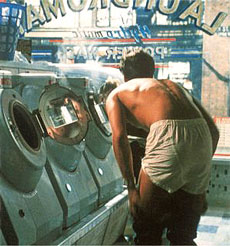
Spin Dryer
QUICK BYTES
TO ALL PUBLICISTS: Owing to the amount of material sent to this newsletter regarding Christmas and New Year's dinners--many of which are only announcements as to price fixed dinners--it is impossible for me to include any but the most unusual of events for those holidays in Quick Bytes. --John Mariani
* In Boston, every Tues. and Fri. evening, Aura will turn its dining room into an impromptu “Romper Room,” complete with toys, and kid-friendly food, called "Fine Dining, Family-Style” while parents can enjoy a sophisticated meal prepared by Chef Rachel Klein. Call 617-385-4300; www.aurarestaurant.com.
* This winter and spring the inn at Blackberry Farm in Walland, TN,
will hold a series of wine dinners with guest chefs. Dinners incl: Jan.
8-11, Taste of the South; March 12-15, Appetite for Life; March
29-April 1: Washington Insider, with Patrick O’Connell of The Inn at
Little Washington, Washington, VA. For complete info visit
http://www.blackberryfarm.com.
* In 2009, Share Our Strength’s A Tasteful Pursuit®, presented by Lexus, presents a national, touring dinner series, launching Jan. 26, at NYC's Lever House. Other tour stops incl. L.A., D.C., Cleveland, Dallas, Nashville and Palm Beach. Funds support Share Our Strength®, a national organization working to make sure no kid in America grows up hungry. Participating chefs incl. Daniel Boulud, Café Boulud, Palm Beach; Terrance Brennan - Artisanal Bistro, NYC; Stephan Pyles - Stephan Pyles Restaurant, Dallas; Jody Adams- Rialto, Boston; Gordon Hamersley- Hamersley’s Bistro, Boston; R.J. Cooper-Vidalia, DC; Michel Richard- Citronelle, DC, et al. Visit www.ATastefulPursuit.org or contact Joe Allegro at 917-834-5335.
* In the Tuscan village of Saturnia, Terme di Saturnia Spa & Golf Resort offers guests the Mediterranean Lifestyle Package, with 2009 rates starting at just €3,300 or $4,528 for double-occupancy for a 4-night stay, with breakfast daily, one Specific Face Treatment, one Full Body Massage and one Four-Hand Massage Shower per person, guided morning hikes, one complimentary dinner at the resort’s All’Acquacotta with a bottle of wine, a signature resort welcome gift and airport transfers. Visit www.termedisaturnia.it.* From Jan. 23-30, The Italian Trade Commission will present "VINO 2009," showcasing more than 270 producers from Abruzzo, Calabria, Lombardia, Toscana , Veneto, and other regions. The program will kick off Jan. 23-25 at the Boston Wine Expo at the Seaport/World Trade Center with a series of seminars and tastings. A 3-day conference in NYC begins Jan. 26, with a welcome reception at the Waldorf Astoria, seminars and tastings at the NY Palace. Weds. grand tasting at the NY Hilton, walk around more than 250 vintners. The Consorzio Brunello di Montalcino will hold its annual "Benvenuto Brunello" to preview the region's five-star-rated 2004 vintage. VINO 2009 will conclude in Miami Jan. 30 at the Intercontinental Hotel with a seminar and walk around tasting. VINO 2009 is open exclusively to wine industry professionals; admission is complimentary. Visit www.italianmade.com/vino2009.
NEW FEATURE: I am happy to report that the Virtual Gourmet is linking up with four excellent travel sites:
Everett Potter's Travel Report:

~~~~~~~~~~~~~~~~~~~~~~~~~~~~~~~~~~~~~~~~~~~~~~~~~~~~~~~~~~~~~~~~~~~~~~~~~~
Eating Las Vegas is the new on-line site for Virtual Gourmet contributor John A. Curtas., who since 1995 has been commenting on the Las Vegas food scene and reviewing restaurants for Nevada Public Radio. He is also the restaurant critic for KLAS TV, Channel 8 in Las Vegas, and his past reviews can be accessed at KNPR.org. Click on the logo below to go directly to his site.
~~~~~~~~~~~~~~~~~~~~~~~~~~~~~~~~~~~~~~~~~~~~~~~~~~~~~~~~~~~~~~~~~~~~~~~~~~~
Tennis Resorts Online: A Critical Guide to the World's Best Tennis Resorts and Tennis Camps, published by ROGER COX, who has spent more than two decades writing about tennis travel, including a 17-year stretch for Tennis magazine. He has also written for Arthur Frommer's Budget Travel, New York Magazine, Travel & Leisure, Esquire, Money, USTA Magazine, Men's Journal, and The Robb Report. He has authored two books-The World's Best Tennis Vacations (Stephen Greene Press/Viking Penguin, 1990) and The Best Places to Stay in the Rockies (Houghton Mifflin, 1992 & 1994), and the Melbourne (Australia) chapter to the Wall Street Journal Business Guide to Cities of the Pacific Rim (Fodor's Travel Guides, 1991). THIS WEEK: A Report on The Four Seasons Jackson Hole. Click on the logo below to go to the site.

Family Travel
Forum: The
Family Travel Forum (FTF), whose motto is "Have Kids, Still Travel!",
is dedicated to the ideals, promotion and support of travel with
children. Founded by business professionals John Manton and Kyle
McCarthy with first class travel industry credentials and global family
travel experience, the independent, family-supported FTF will provide
its members with honest, unbiased information, informed advice and
practical tips; all designed to make traveling a rewarding, healthy,
safe, better value and hassle-free experience for adults and children
who journey together. Membership in FTF will lead you to new worlds of
adventure, fun and learning. Join the movement.
All You Need to Know Before You Go
~~~~~~~~~~~~~~~~~~~~~~~~~~~~~~~~~~~~~~~~~~~~~~~~~~~~~~~~~~~~~~~~~~~~~~~~~
MARIANI'S VIRTUAL GOURMET NEWSLETTER is published weekly. Editor/Publisher: John Mariani.
Contributing Writers: Robert Mariani,
John A. Curtas, Edward Brivio, Mort
Hochstein, Suzanne Wright, and Brian Freedman. Contributing
Photographers: Galina Stepanoff-Dargery, Bobby Pirillo. Technical
Advisor: Gerry McLoughlin.
Any of John Mariani's books below
may be ordered from amazon.com by clicking on the cover image.
 My
newest book, written with my brother Robert Mariani, is a memoir of our
years growing up in the My
newest book, written with my brother Robert Mariani, is a memoir of our
years growing up in the For those of you who don't think of the Robert and I think you'll enjoy this very personal look at our --John Mariani |
 |
 |
 |
 |
 |
 |
© copyright John Mariani 2008
